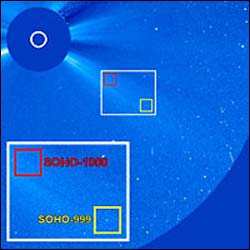History’s greatest comet hunter discovers 1000th comet

999th and 1000th comets identified in SOHO images
On 5 August 2005, the ESA/NASA SOHO spacecraft achieved an incredible milestone – the discovery of its 1000th comet!
The 1000th comet was a Kreutz-group comet spotted in images from the C3 coronagraph on SOHO’s LASCO instrument by Toni Scarmato, from Calabria, Italy. Just five minutes prior to discovering SOHO’s 1000th comet, Toni had also spotted SOHO’s 999th comet! These comets take Toni’s personal number of SOHO discoveries to 15.
Many SOHO comet discoveries have been by amateurs using SOHO images on the internet, and SOHO comet hunters come from all over the world. Toni Scarmato, a high school teacher and astrophysics graduate of the University of Bologna, said: “I am very happy for this special experience that is possible thanks to the SOHO satellite and NASA-ESA collaboration.
“I want to dedicate the SOHO 1000th comet to my wife Rosy and my son Kevin to compensate for the time that I have taken from them to search for SOHO comets.”
The SOHO team also held a contest over the internet to guess the time when the 1000th comet would be discovered. The contest winner is Andrew Dolgopolov of Dublin, Ireland, who guessed the time of the comet’s closest approach to the Sun (perihelion time) within 22 minutes.
SOHO, the Solar and Heliospheric Observatory , is a joint effort between NASA and ESA and is now in its tenth year of operation. Although it was originally planned as a solar and heliospheric mission, it was optimistically hoped that LASCO might observe at least a handful of ‘sungrazer’ comets, based on the success of the SOLWIND coronagraph in the late 1970s and 1980s, which discovered a small number of very bright Kreutz-group comets.
It was not long after SOHO began sending down a steady stream of data in 1996 that SOHO scientists spotted a Kreutz-group comet in LASCO images. Soon, several more comets had been found and word started to spread of SOHO’s potential as a comet discoverer.
In 2000, amateur astronomer Mike Oates started to search the SOHO images, which had recently became available via the internet. He soon revealed just how much potential SOHO had by quickly spotting over 100 comets in LASCO images.
Almost all SOHO’s comets are discovered using images from its LASCO instrument, the Large Angle and Spectrometric Coronagraph. LASCO is used to observe the faint, multimillion-degree outer atmosphere of the Sun, called the corona. A disk in the instrument is used to make an artificial eclipse, blocking direct light from the Sun so the much fainter corona can be seen. Sungrazing comets are discovered when they enter LASCO’s field of view as they pass close by the Sun.
As time passed, more professional astronomers, as well as amateur enthusiasts from all over the world, joined the search for SOHO comets. In August 2002, Rainer Kracht (now the leading SOHO comet discoverer, with over 150 SOHO comets) spotted SOHO’s 500th comet. This in itself was an achievement that none of the SOHO/LASCO scientists ever imagined would, or could, happen.
However, just three years later, SOHO, with 1000 comet discoveries, is responsible for almost half of all officially recorded comets in history! Add to this the fact that the SOHO mission has completely revolutionised solar physics and the understanding of the Sun, and it shows just how truly amazing the SOHO spacecraft is!
Media Contact
More Information:
http://www.esa.int/esaCP/SEMCA3908BE_index_0.htmlAll latest news from the category: Physics and Astronomy
This area deals with the fundamental laws and building blocks of nature and how they interact, the properties and the behavior of matter, and research into space and time and their structures.
innovations-report provides in-depth reports and articles on subjects such as astrophysics, laser technologies, nuclear, quantum, particle and solid-state physics, nanotechnologies, planetary research and findings (Mars, Venus) and developments related to the Hubble Telescope.
Newest articles

NASA: Mystery of life’s handedness deepens
The mystery of why life uses molecules with specific orientations has deepened with a NASA-funded discovery that RNA — a key molecule thought to have potentially held the instructions for…

What are the effects of historic lithium mining on water quality?
Study reveals low levels of common contaminants but high levels of other elements in waters associated with an abandoned lithium mine. Lithium ore and mining waste from a historic lithium…

Quantum-inspired design boosts efficiency of heat-to-electricity conversion
Rice engineers take unconventional route to improving thermophotovoltaic systems. Researchers at Rice University have found a new way to improve a key element of thermophotovoltaic (TPV) systems, which convert heat…



